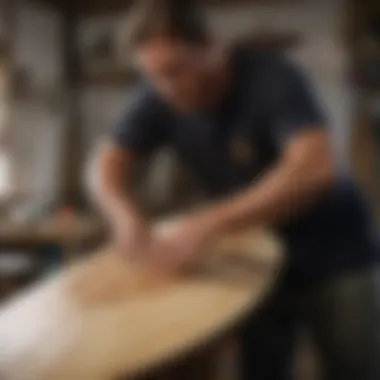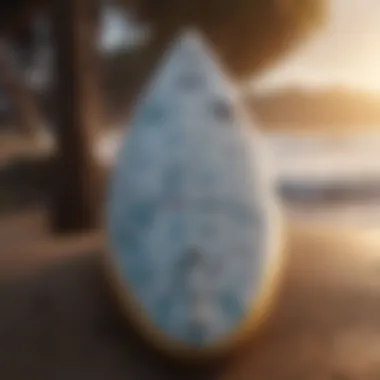Mastering the Craft: The Intricate Art of Carving Surfboards Unveiled


Surfboard Gear and Equipment
- Selecting the appropriate surfboard and equipment is fundamental in enhancing a surfer's performance and comfort while riding waves. Considering the types of surfboards available, such as shortboards, longboards, and fish boards, enables surfers to choose a design that complements their surfing style and skill level. Essential surfing accessories like leashes, fins, and wetsuits contribute to safety and functionality in varying water conditions. Matching the surfboard to individual skill levels ensures a seamless transition from beginner to advanced maneuvers, facilitating skill progression. Regular maintenance and upgrades to surfing gear, including inspecting for wear and tear, replacing outdated equipment, and staying abreast of surfing technology innovations, optimize performance and enjoyment on the waves.
Introduction
Understanding Surfboard Carving
History of Surfboard Carving
Exploring the origins of surfboard carving unveils a rich tapestry of tradition and innovation that has shaped modern board design. From the ancient Polynesians crafting boards out of solid wood to the foam and fiberglass revolution in the 20th century, each era has left a distinct imprint on surf culture. The history of surfboard carving serves as a vital link to our past, honoring the legacy of those who paved the way for contemporary board shaping techniques. Understanding this historical timeline provides valuable insights into the evolution of surfboard craftsmanship and the enduring appeal of hand-shaped boards.
Evolution of Design Techniques
The evolution of design techniques in surfboard carving signifies a constant quest for refinement and performance enhancement. Innovations in shaping technology, such as CADCAM software and CNC cutting machines, have revolutionized the precision and consistency of board production. While traditional hand shaping remains a cherished art form, modern design techniques offer surfboard shapers a playground of possibilities to push the boundaries of performance. By embracing new materials, shaping methods, and construction innovations, surfboard designers can tailor boards to meet the demands of various wave conditions and surfing styles, leading to a more personalized and optimized riding experience.
Materials Selection
When delving into the intricate process of carving surfboards, one cannot overstate the critical importance of materials selection. The quality and characteristics of the materials utilized in crafting a surfboard play a significant role in the board's performance, durability, and overall surfing experience. Selecting the right materials can make a substantial difference in the board's buoyancy, maneuverability, and responsiveness to the waves. As such, surfboard craftsmen must carefully consider various elements such as the type of foam blanks and fiberglass options available in the market, ensuring that the chosen materials align with the desired performance and design objectives.
Choosing the Right Materials
Types of Foam Blanks
When it comes to carving surfboards, the choice of foam blanks is a pivotal decision that impacts the board's characteristics and performance. Foam blanks serve as the core material from which the surfboard takes shape, providing buoyancy and structural integrity to the final product. Different types of foam blanks offer varying characteristics in terms of weight, density, and flexibility, influencing how the board will ride on the waves. Surfers often opt for foam blanks that strike a balance between lightness for easy maneuvering and durability to withstand the rigors of surfing. Understanding the unique properties of each foam blank type allows craftsmen to tailor the surfboard's design and performance to suit different surfing styles and wave conditions.


Fiberglass Options
In the realm of surfboard construction, fiberglass is a widely favored material known for its strength, flexibility, and versatility. Fiberglass options come in different weaves, weights, and finishes, each influencing the board's performance and durability. Surfboard craftsmen carefully select fiberglass options based on factors such as the desired flex pattern, the level of responsiveness sought, and the board's intended use. The application of fiberglass provides structural reinforcement to the surfboard, contributing to its overall sturdiness and longevity. By choosing the right fiberglass option, craftsmen can impart specific characteristics to the board, enhancing its performance in varying wave conditions and surfing scenarios.
Shaping Process
In the realm of surfboard craftsmanship, the Shaping Process holds paramount importance. This pivotal stage bridges the gap between conceptual design and tangible form, where the surfboard begins to take shape, quite literally. Precision is key in this phase as even minor adjustments can significantly influence the board's performance on the waves. The Shaping Process embodies the marriage of technical expertise and creative flair, where each carve and contour plays a critical role in the final product. Skilled craftsmen devote meticulous attention to detail, sculpting the board with a finesse that can only be honed through experience and dedication.
Crafting the Surfboard Shape
Utilizing Shaping Tools
Within the Crafting the Surfboard Shape section, the aspect of Utilizing Shaping Tools emerges as a cornerstone of the entire process. Shaping tools are more than mere instruments; they are extensions of the artisan's hands, translating vision into reality with each precise movement. These tools, ranging from traditional hand planes to modern shaping machines, offer unparalleled control over the board's contours and dimensions, enabling the craftsman to sculpt with unparalleled precision. One standout characteristic of Utilizing Shaping Tools is their versatility, allowing craftsmen to adapt to varying design requirements and techniques seamlessly. While each tool boasts unique functionalities, their collective contribution lies in the seamless execution of design visions, ensuring consistency and accuracy in every cut and curve.
Perfecting the Outline
Turning attention to Perfecting the Outline, this aspect elevates the surfboard's aesthetics and functionality to new heights. The outline serves as the blueprint for the board's performance characteristics, dictating maneuverability, stability, and overall surfing experience. Craftsmen meticulously refine the outline, striking an intricate balance between performance-driven features and artistic appeal. A key characteristic of Perfecting the Outline is its role in fine-tuning the board's hydrodynamics, optimizing glide and responsiveness on the waves. This meticulous process involves carefully shaping curves, tail configuration, and rail profiles to achieve the desired surfing attributes. While Perfecting the Outline demands precision and expertise, its rewards manifest in surfboards that not only excel in performance but also stand as works of art in their own right.
Refining Techniques
In the realm of surfboard carving, refining techniques play a crucial role in the quality and performance of the final product. These techniques encompass a series of meticulous adjustments and touches that fine-tune the board's characteristics to optimize its functionality on the waves. From honing the rails to shaping the tail, every refinement contributes to enhancing the overall surfing experience. The mastery of refining techniques requires a keen eye for detail and a deep understanding of how slight modifications can significantly impact a board's performance.
Certain factors need to be considered when delving into refining techniques. The materials used, such as the types of foam blanks and fiberglass options, greatly influence the effectiveness of these techniques. Additionally, the skill and precision of the craftsman in executing these refinements are paramount, as even minor errors can alter the board's dynamics.
Furthermore, refining techniques are not just about fine-tuning performance but also about achieving a harmonious balance between control, speed, and maneuverability. By experimenting with various refinements and analyzing their effects, craftsmen can tailor surfboards to meet the specific needs and preferences of surfers, ensuring an unparalleled ride on the waves.


Fine-Tuning Performance
Rail Design
Rail design holds a pivotal role in determining a surfboard's performance in the water. These design elements refer to the edges running along the sides of the board, dictating its responsiveness, grip, and stability on different wave conditions. The shape, angle, and thickness of the rails impact how the board interacts with the water, influencing the surfer's ability to carve, turn, and maneuver with precision.
A key characteristic of rail design is its versatility. By adjusting the rail shape, craftsmen can customize a board to suit specific styles of surfing, whether it's for aggressive maneuvers in powerful waves or smooth, flowing rides in milder conditions. The rounded rails offer better forgiveness and maneuverability, while sharper rails provide enhanced control and bite, ideal for high-speed turns.
Tailoring rail design to match the surfer's skill level and surfing objectives is essential for optimal performance. While rounded rails are more forgiving and user-friendly, sharper rails cater to experienced surfers seeking greater responsiveness and edge hold. Understanding the nuances of rail design allows craftsmen to craft boards that elevate the surfing experience, giving surfers the confidence and control to push their limits on the waves.
Tail Variations
Tail variations are another critical aspect of fine-tuning a surfboard's performance to meet the demands of different wave conditions and surfing styles. The tail shape significantly influences the board's speed, stability, and turning capabilities, affecting how it responds to the surfer's input in various maneuvers. Whether it's a squash tail, round tail, or swallowtail, each variation offers distinctive advantages suited to specific surfing preferences.
The key characteristic of tail variations lies in their impact on water flow around the board. A narrower tail generates greater speed and responsiveness, perfect for quick, sharp turns and high-performance surfing. In contrast, wider tails provide more stability and buoyancy, ideal for cruising and catching smaller waves with ease.
Choosing the right tail variation depends on the surfer's surfing style and the wave conditions they frequent. Surfers looking to execute tight turns and aerial maneuvers may prefer a swallowtail for improved control, while those aiming for speed and flow opt for a round tail design. By understanding the nuances of tail variations, craftsmen can craft surfboards that amplify the surfer's abilities, enabling them to make the most of every wave they encounter.
Artistic Expression
The section on Artistic Expression within this article on surfboard carving delves into the crucial role of creativity in enhancing the overall design and performance of surfboards. Artistic Expression goes beyond mere functionality, allowing surfboard craftsmen and artists to infuse individuality and style into their creations. By integrating custom artwork into surfboards, designers can create unique boards that not only excel in performance but also stand out in a sea of standard designs. This section explores how the fusion of art and functionality in surfboard carving elevates the surfing experience, catering to the aesthetic sensibilities of surf enthusiasts. Moreover, the careful integration of Artistic Expression in surfboard carving showcases the craftsmanship and dedication of artisans towards creating bespoke boards that embody both form and function.
Custom Artwork Integration
Airbrushing Techniques


Airbrushing Techniques play a pivotal role in Custom Artwork Integration, offering a versatile and precise method for applying intricate designs to surfboards. The use of airbrushing allows artists to create detailed illustrations, gradients, and textures, enhancing the visual appeal of the board. This technique provides a high level of control and consistency in design application, ensuring that each board receives a customized and flawless finish. Airbrushing Techniques are particularly favored for their ability to achieve intricate patterns and vibrant colors, making them a preferred choice for surfboard customization. While airbrushing requires skill and finesse to master, its ability to bring artistic visions to life on surfboards makes it a valuable tool in the realm of Custom Artwork Integration.
Resin Tint Options
Resin Tint Options offer a spectrum of vibrant hues that can transform surfboards into stunning works of art. With Resin Tints, designers have the flexibility to create custom color blends, effects, and finishes that cater to individual preferences and styles. The key characteristic of Resin Tints lies in their ability to enhance the visual impact of surfboards, adding depth and dimension to the overall design. These options are popular for their durability and UV resistance, ensuring that the colors remain vibrant even after prolonged exposure to sunlight. While Resin Tint Options provide unparalleled creative possibilities, they require expertise in application to achieve optimal results. Understanding the advantages and disadvantages of different Resin Tint Options is essential for surfboard craftsmen looking to create visually striking and durable custom boards.
Performance Testing
In the realm of surfboard carving, Performance Testing stands as a pivotal stage that scrutinizes every intricacy of the board’s design and construction, aiming to optimize its functionality and responsiveness. Through Performance Testing, surfboard craftsmen can fine-tune elements such as buoyancy, maneuverability, and speed, ensuring that the final product meets the exacting standards of surf enthusiasts. This section delves into the significance of subjecting surfboards to rigorous testing protocols, ensuring that they not only meet but exceed expectations.
Optimizing Board Performance
Wave Simulation Testing
Wave Simulation Testing simulates the real-life conditions surfers encounter on the waves, allowing craftsmen to evaluate how a board performs in different wave types. It provides valuable insights into the board's stability, agility, and overall handling characteristics, aiding in refining its design for optimal performance. By subjecting prototypes to simulated waves with varying intensities and shapes, craftsmen can iteratively enhance the board's performance in a controlled environment, minimizing the need for extensive field testing. Wave Simulation Testing offers a cost-effective and efficient means of assessing a surfboard's performance under diverse conditions, making it an indispensable tool in the arsenal of every surfboard artisan.
Surfer Feedback Analysis
Surfer Feedback Analysis involves gathering input from experienced surfers who test the boards in actual surfing conditions, providing invaluable firsthand insights into the board's performance attributes. By collating and analyzing surfer feedback, craftsmen can identify strengths, weaknesses, and areas for improvement in the board's design, allowing for targeted iterations to enhance its overall performance. Surfer Feedback Analysis complements Wave Simulation Testing by offering real-world validation of the board's performance, bridging the gap between theoretical analysis and practical applicability. Leveraging surfer feedback enables craftsmen to fine-tune subtle nuances in the board's design, aligning it with the preferences and expectations of the surfing community.
Conclusion
In the realm of surfboard carving, the concluding phase plays a crucial role in determining the success and performance of the final product. The thorough understanding of the intricate details and nuances involved in each carving process is vital. Embracing the elements of continuous learning and innovation elevates the craftsmanship to a new level of artistry. The commitment to honing skills and staying abreast of the latest trends and technologies is what sets exceptional surfboard carvers apart. Every stroke, every carve is a step towards perfection that can only be achieved through dedication and a thirst for improvement.
Mastering the Art of Surfboard Carving
Continuous Learning and Innovation
Continuous learning and innovation are the cornerstones of progress in the field of surfboard carving. The quest for perfection drives carvers to continuously seek new techniques, materials, and design concepts. By embracing a growth mindset, surfboard carvers remain at the forefront of the industry, constantly pushing boundaries and exploring uncharted waters. The willingness to experiment and adapt to evolving trends allows for the creation of cutting-edge surfboards that deliver unparalleled performance on the waves.
Embracing the Craftsmanship
Embracing the craftsmanship aspect of surfboard carving is about more than just skill; it is a reverence for the rich history and tradition that underpin this art form. The art of surfboard carving is a fusion of technical precision and artistic expression, where every curve and contour reflects the carver's dedication to their craft. By honoring the legacy of master craftsmen who came before them, modern carvers are able to imbue their work with a sense of timelessness and integrity. Embracing craftsmanship ensures that each surfboard created is not just a tool for riding waves but a work of art that stands the test of time.







